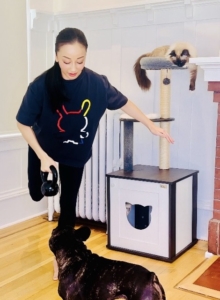Advanced One Foot Balance Exercise
Overview
This progressive balance routine strengthens the glutes, core, hips, legs, and ankles while improving coordination and stability. Starting with simple single-leg stands and advancing to weighted movements and unstable surfaces, it builds strength, control, and confidence in everyday movements — helping prevent falls and improving overall functional fitness.
Level
Advanced
Targets
Balance
Step by Step Instructions
Level 1: Beginner Balance
Single-Leg Stand with Toe Tap
- Stand on one leg with your opposite toe lightly resting on the ground for support.
- Gradually lift your toe off the ground for 1–2 seconds, then return it.
- Work up to holding your foot off the ground for 30 seconds.
Add Arm Movement
- Stand on one leg and slowly swing your arms around to challenge your stability.
Eyes-Closed Balance
- Stand on one leg and close your eyes, holding for as long as you can while maintaining control.
Level 2: Intermediate Balance
Single-Leg Reach Back
- Stand on one leg.
- Lean back, lightly touch your toe to the ground, then bring your knee back up.
- Repeat several times per leg.No-Touch Single-Leg Reach
- Perform the same movement as above but don’t touch your toe to the ground — this increases core and glute activation.Add Arm Reach
- As you hinge back, reach your opposite arm toward the floor while your leg extends behind you.
- Return to standing and repeat.
Level 3: Advanced Balance
Weighted Single-Leg Deadlift
- Hold a kettlebell or weight in one hand.
- Hinge at your hips, lower the weight toward the ground, then return to standing.
- Progress by bringing the weight to your shoulder and pressing it overhead before returning to start.Unstable Surface Challenge
- Perform any of the above exercises standing on a balance disc, wobble cushion, or BOSU ball.
- This adds instability and significantly increases the difficulty.
Tips
- Keep your core engaged and shoulders relaxed.
- Maintain a neutral spine — avoid rounding or arching your back.
- Start slow and build up as your stability improves.
- Perform 2–3 sets per leg, working up to 30 seconds per hold or 8–12 repetitions per movement.
Benefits
This routine strengthens your glutes, core, feet, and ankles, improves coordination and proprioception, and helps prevent falls by training your body to stabilize in multiple planes of motion.
[Video Transcript]
We often think about working out our muscles in the form of weight training or working out our heart through cardiovascular training, but what we often forget is to work on our balance. When you’re young, balance feels easy because your body naturally makes compensation adjustments, and you might even be able to stand on one leg all day, sometimes with your eyes closed.
I often encourage patients to start simply, such as standing on one leg while washing the dishes. If that’s easy, you need to increase the intensity of your balance exercises. One of the best balance exercises is one that has built-in progressions, allowing you to start easy and gradually make it harder.
If you have trouble balancing, start by standing on one leg with your toe resting lightly on the ground. Try lifting your toe for one second, then two seconds, and work up to holding it off the ground for 30 seconds. Once you can do that, make it more challenging, try balancing while swinging your arms around to throw yourself slightly off balance. Then try standing on one leg with your eyes closed, which increases the challenge significantly.
If that’s easy, redistribute your weight to make it harder. Stand on one leg and lean back, touching your toe to the ground, then bring your knee back up. You can make it more difficult by leaning back and coming up without touching your toe to the ground at all. You’ll notice your glutes and core working hard to stabilize you.
To further increase intensity, add arm movements. For example, while standing on one leg, hinge at your hips, reaching your opposite arm toward the ground as your leg goes back, then return to standing. You can also swing your arms upward as you come back up. Not only will you feel this in your core and glutes, but also in your feet, ankles, and legs.
For an advanced progression, add weight using a kettlebell. Hold the kettlebell in one hand, hinge at the hips, and lower your torso, then come back to standing. Once that becomes easy, add an overhead press by bringing the kettlebell to your shoulder and then pressing it overhead. This turns the movement into a full-body workout, challenging your balance, strength, and coordination.
For the most advanced version, stand on a balance disc, wobble cushion, or BOSU ball while performing these movements. You can also gradually increase the weight of your kettlebell. This progression is tough but an excellent way to improve your balance and overall stability.
Try it out and see how it feels!
Back to All Home Exercises
Download our Full Guide on Stretches and Exercises
If you’re looking for a chiropractor in Victoria, look no further than Mind Body Spine chiropractic clinic near uptown.

